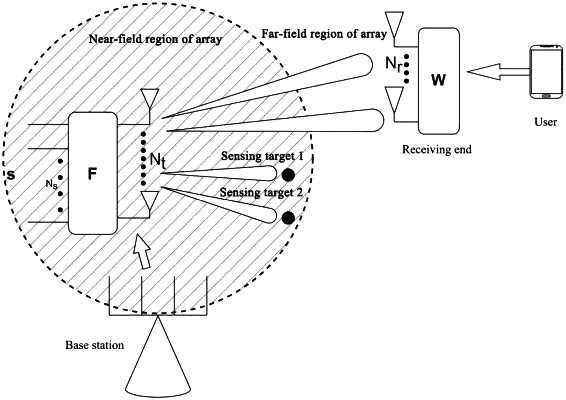| CPC G01S 7/4008 (2013.01) [H01Q 3/40 (2013.01)] | 7 Claims |

|
1. An emission beamforming method of a multi-antenna integrated system combining near-field sensing and far-field communication, comprising a computer readable medium operable on a computer with memory for the emission beamforming method of a multi-antenna integrated system combining near-field sensing and far-field communication, and comprising program instructions for executing the following steps:
(i) establishing a communication signal transmission model and a communication channel model, and analyzing an upper limit of communication spectrum efficiency;
(ii) acquiring an optimal communication beam matrix Fcom based on the communication channel model in step (i);
(iii) establishing a sensing near-field region signal model;
(iv) generating an optimal radar beam matrix Frad based on an antenna array response vector of a radar detection target;
(v) introducing a compromise factor to construct an initial optimization problem of an integrated beamforming matrix in power constraint based on the established sensing near-field region signal model;
(vi) transforming and solving the constructed initial optimization problem of an integrated beamforming matrix in step (v) to obtain the integrated beamforming matrix; and
(vii) improving performance for the near-field sensing and increasing capability of the far-field communication based on the integrated beamforming matrix;
wherein
in step (iii), the sensing near-field region signal model is represented as a directional pattern of a near-field region radar emission signal P(θ, r), as shown in formula (IX):
P(θ,r)=a(θ,r)RaH(θ,r) (IX);
in the formula (IX), R represents a covariance matrix of the emission signal;
in step (iv), the generating an optimal radar beam matrix Frad based on an antenna array response vector of a radar detection target specifically comprises:
a) making a design of a radar detection signal x equivalent to a design of an emission beamforming matrix F, wherein due to a covariance matrix of the emission signal R=E (xxH)=E(Fs(Fs)H)=FFH, formula (IX) is represented by formula (X):
P(θ,r)=atH(θ,r)Rat(θ,r)=∥FHat(θ,r)∥F2 (X), and
b) generating the optimal radar beam matrix Frad directly based on the antenna array response vector of the radar detection target, wherein an emission front end is a hybrid modulus fully-connected structure, the optimal radar beam matrix Frad is constructed as formula (XI):
Frad=[v1 v2 . . . vtar]∈□Nt×Ntar (XI);
in the formula (XI), vi is an element in an array steering vector:
 is the number of the detection targets, a(θi,ri) represents a steering vector at which an ith detection target is located, and θi and ri represent an angle and a distance of the ith target;
a radar performance measurement index is defined as an Euclidean distance between the emission beamforming matrix F and the optimal radar beam matrix Frad: ∥F−Frad∥F2;
in step (v), the introducing a compromise factor to construct an initial optimization problem of an integrated beamforming matrix in power constraint based on the established sensing near-field region signal model means that emission power is taken as constraint, an target function is to minimize a sum of Euclidean distances between an emission beamforming matrix F, the optimal radar beam matrix Frad and the optimal communication beam matrix Fcom with the compromise factor being introduced, and the optimization problem, namely, the initial optimization problem of an integrated beamforming matrix is established and represented by formula (XII):
 in the formula (XII), Fcom represents the optimal beam matrix for communication, Frad represents the optimal beam matrix of an radar, η represents the compromise factor within [0, 1], and PT represents total emission power; and
in step (vi), the transforming and solving the constructed initial optimization problem of an integrated beamforming matrix in step (5) to obtain the integrated beamforming matrix specifically comprises:
a) constructing auxiliary variables A=[√ηINtT, √1−ηINtT]T∈
 2Nt×Nt and B=[√ηFcomT,√1−ηFradT]T∈ 2Nt×Nt and B=[√ηFcomT,√1−ηFradT]T∈ 2Nt×Ns, and converting formula (XI) into a quadratic constrained and quadratic programming problem in an equivalent form, as shown in formula (XIII): 2Nt×Ns, and converting formula (XI) into a quadratic constrained and quadratic programming problem in an equivalent form, as shown in formula (XIII): b) introducing E=INs⊗A, f=vec(F), b=vec(B), t=±1, in which vec (□) represents an column vector stacking operation, ⊗ represents a Kronecker product, and the formula (XIII) is deformed to obtain formula (XIV):
 c) constructing
 wherein the initial optimization problem of an integrated beamforming matrix is re-represented by formula (XV):
 d) ignoring non-convex constraint of rank(Y)=1 by a semi-definite relaxation method, wherein in the formula (XV), only rank(Y)=1 is non-convex, the problem becomes a semi-definite programming problem and is represented by formula (XVI):
 and
the formula (XVI) is a convex optimization problem, and Y is solved by a CVX toolbox in MATLAB, and
e) solving formula (XVII) and separating y from Y based on the constructed
 in the step b):
min∥Y−yyH∥F2 (XVII),
giving a root of a maximum eigenvector multiplied by a maximum eigenvalue of Y equal to an optimal solution y of the formula (XVII), eliminating a last element in the optimal solution y to obtain f=vec(F) in the step a), and recombining elements in f into a matrix F with a dimension being Nt×Ns to obtain the integrated beamforming matrix.
|